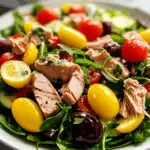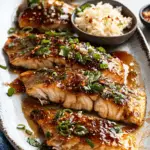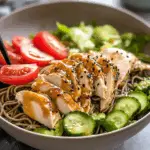The golden, crackling texture of this Crispy Salt & Pepper Squid is exactly what every fried seafood lover dreams of. Made with a precision-tested batter using the perfect ratio of cornflour and flour, this dish comes out ultra-crunchy and never greasy.
Double-fried to lock in the crunch, this squid is light yet packed with bold flavors. Whether you serve it with lemon wedges or a garlicky aioli dip, it’s an impressive appetizer or satisfying main that delivers every time. Perfect for entertaining or indulging yourself with a restaurant-quality plate at home!
Full Recipe:
For the Squid:
-
500g (1 lb) squid tubes or 700g whole baby squid, cleaned
-
Paper towels (for drying)
For the Batter:
-
2/3 cup cornflour (cornstarch)
-
1/3 cup plain/all-purpose flour
-
1/2 tsp baking powder
-
1/2 tsp kosher salt
-
1/4 tsp white pepper powder
-
2/3 cup cold tap water
For Frying & Seasoning:
-
3–4 cups vegetable oil (for frying)
-
Extra kosher salt and white pepper to taste
Optional Garlic Aioli:
-
1/2 cup whole egg mayonnaise or Kewpie
-
1/2 tsp finely grated garlic
Directions:
-
If using squid tubes, cut one side open and lay flat. Pat dry thoroughly. Lightly score the inside in a crisscross diamond pattern, then cut into 2″x1″ rectangles.
-
In a mixing bowl, whisk cornflour, flour, baking powder, salt, and pepper. Slowly whisk in water until the batter is smooth. Refrigerate for 30 minutes (do not skip this step).
-
Heat oil in a deep pot to 160°C/320°F. Dip all squid pieces into batter and coat well.
-
Working in 3 batches, fry squid pieces for 2–3 minutes until light golden. Drain on paper towels.
-
Increase oil temperature to 200°C/390°F. Fry squid again in 2 batches for 90 seconds until deeply golden and ultra-crispy. Drain and lightly season with extra salt and white pepper.
-
For aioli: Mix mayonnaise and garlic in a small bowl and let sit for at least 20 minutes.
-
Serve squid hot with aioli or lemon wedges.
Prep Time: 15 minutes | Cooking Time: 15 minutes | Total Time: 30 minutes
Kcal: Approx. 310 kcal per serving | Servings: 4 as a main, 6–8 as appetizer
Introduction to Crispy Salt & Pepper Squid
Crispy Salt & Pepper Squid is more than just a crowd-pleasing appetizer — it’s a beloved dish across cultures and cuisines, known for its addictively crunchy coating and tender seafood center. It’s particularly revered in Chinese and Southeast Asian restaurants, where it’s often served as a starter or part of a shared banquet-style meal. The magic of this dish lies in its simplicity. At first glance, it’s just battered and fried squid with a basic seasoning. But the attention to detail in technique and batter composition is what elevates it from good to unforgettable.
What sets a truly great Salt & Pepper Squid apart is the texture — a perfect balance between an airy crunch and moist, tender squid. When cooked properly, it’s light, not greasy, with a brittle crust that doesn’t turn soggy even as it cools. This is the benchmark that many home cooks and professionals strive for, but often miss without the right methods.
Why This Recipe Works
This recipe was developed with years of testing and refinement to create a fry batter that stays crispy long after the squid comes out of the oil. The batter’s secret lies in a precise ratio of two types of flour — plain flour and cornflour (also known as cornstarch). Cornflour brings the signature shatteringly crisp texture, while the plain flour contributes structure and a golden color.
Another critical factor is refrigeration. Resting the batter in the fridge for 30 minutes before frying allows the gluten in the flour to relax and develop. This may sound counterintuitive, as gluten development is often discouraged in light batters, but in this case, it ensures the batter adheres well to the slippery surface of the squid. Without this step, the coating may slip off during frying or cook up greasy and uneven.
Moreover, this dish employs the double-frying technique — a widely accepted culinary method used in high-end kitchens and Asian street stalls alike. The first fry gently cooks the squid and sets the batter. After a short rest, a second, hotter fry crisps everything up and drives out residual moisture, locking in that crunch. This method is what gives the squid its remarkable texture — crispy on the outside, and juicy but not rubbery inside.
Understanding the Role of Ingredients
Although we won’t dive into the specific ingredient list, it’s important to understand how the elements work together on a chemical and sensory level.
The flours are carefully chosen and balanced to create a golden, delicate crust that doesn’t fall apart or become chewy. A small amount of baking powder adds a subtle lift, preventing the crust from being too dense or heavy.
Seasonings are intentionally kept minimal — just salt and white pepper — so the natural sweetness of the squid shines through. The simplicity enhances the purity of the seafood, with the pepper providing a gentle warmth without overwhelming the dish. Optional dips like garlic aioli add another dimension, but even without them, the squid is flavorful and satisfying.
Cooking Technique: The Game Changer
For home cooks unfamiliar with frying, this recipe is a great entry point. Unlike fried chicken or large seafood pieces, squid cooks extremely fast and evenly. The small size and light batter reduce the risk of undercooking or burning. Frying in small batches ensures consistent oil temperature, preventing soggy results.
Temperature control is crucial. Starting with a medium heat ensures the squid cooks without overbrowning. Then, raising the heat for the second fry creates the final crispy finish. This two-step process not only improves texture but also minimizes oil absorption.
Cutting technique also contributes to success. Scoring the squid into a diamond pattern before cutting into bite-sized pieces allows for faster cooking and more surface area for the batter to cling to. It also creates those delicious little crispy ridges that catch seasoning and provide texture in every bite.
Texture and Flavor Balance
Salt & Pepper Squid is a dish all about contrasts. The outer crust delivers an audible crunch, while the squid inside remains juicy and tender. When the seasoning is right — not too salty, not too bland — every piece is flavorful without overpowering your palate.
Squid, being a delicate protein, needs only a short cooking time to stay soft. Overcooking results in rubbery, chewy bites — a common complaint when the squid is fried too long or in oil that’s not hot enough. This recipe sidesteps that problem entirely through careful timing and preparation.
The end result is a dish that feels indulgent without being heavy. It satisfies the craving for something fried and savory while still showcasing the freshness of the seafood. That’s a rare balance, and one that makes this recipe a winner for any occasion — from casual dinners to special celebrations.
Reheating and Storage Tips
While most fried foods lose their appeal when reheated, this recipe is an exception. Thanks to the unique batter and double-fry method, leftovers maintain their crunch surprisingly well.
Stored in an airtight container in the fridge, the squid can be reheated in a preheated oven at 220°C (425°F) for about 6–8 minutes. The crust crisps right back up, and the squid inside warms without turning rubbery. This makes the dish not only delicious fresh out of the fryer but also a convenient make-ahead option for parties or meal prep.
Pairing and Serving Ideas
Salt & Pepper Squid is versatile and adaptable to a wide range of side dishes and accompaniments. For a light meal, serve it with a simple green salad, steamed jasmine rice, or a cold noodle dish. For something more indulgent, offer it with French fries and a selection of dipping sauces like garlic aioli, spicy mayo, or sweet chili sauce.
You can also use the squid as a topping for Asian-style rice bowls, stuffed in bao buns with pickled veggies, or served alongside beer or a chilled white wine for an ideal appetizer. However you plate it, the squid is always the star.
Cultural Significance and Global Appeal
Though Salt & Pepper Squid is often found in Chinese restaurants, especially Cantonese and Sichuan cuisines, its appeal is truly global. In Australia, the UK, and parts of North America, it’s a common feature on seafood menus and pub grub lists. Variations include different spice blends, herbs like fresh chili or green onions, or even crusts incorporating breadcrumbs or panko.
Despite regional differences, the core of the dish remains the same: quick-fried squid, properly seasoned, and served fresh. This speaks to the universal love for dishes that are simple, flavorful, and texturally satisfying.
The dish also reflects the essence of good cooking — using technique and quality ingredients to turn something humble into something memorable. It may not be flashy or complex, but when made right, it’s nothing short of extraordinary.
Conclusion: Why You Should Try This Version
This Salt & Pepper Squid recipe is more than just another way to cook seafood — it’s a celebration of texture, balance, and smart cooking techniques. With its double-fry method, chilled batter, and carefully chosen flour blend, it outperforms many restaurant versions and offers consistent, restaurant-quality results at home.
Whether you’re new to cooking squid or looking to perfect your existing method, this recipe offers valuable insights and a reliable blueprint. It honors the traditional flavors while incorporating modern culinary science for an unbeatable result.
If you’re seeking a dish that’s impressive but easy, indulgent but not greasy, and bold in texture and flavor, this is the recipe to master. Salt & Pepper Squid deserves a spot in your regular rotation — not just because it’s delicious, but because it showcases how a few smart tweaks can transform the ordinary into the extraordinary.






